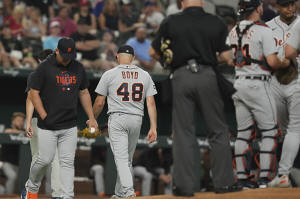There's no easy answers for slowing
down rising level of pitching injuries at all levels of baseball
[March 26, 2025]
By STEVE MEGARGEE
GOODYEAR, Ariz. (AP) — Figuring out a cause for the skyrocketing
number of arm injuries among pitchers is easy.
Finding a solution could prove much more challenging.
Major League Baseball issued a 62-page report in December that
showed how the focus on throwing with increased velocity and using
maximum effort on every pitch was a likely reason for the increase
in injuries. The study provided numerical data backing a thesis
already supported by conventional wisdom.
“It makes sense,” Cleveland Guardians right-hander Tanner Bibee
said. “You do anything at a max capacity, you’re going to be at more
risk for injury. If you try to squat your absolute max, you’re going
to get hurt more often than if you’re squatting a plate and a bar.
It’s just kind of the nature of anything you do in life.”
The study showed that major league pitcher injured list placements
increased from 212 in 2005 to 485 in 2024. Days on the IL rose from
13,666 to 32,257.
Tommy John surgeries for major and minor league players increased
from 104 in 2010 to a peak of 314 in 2020, though they slipped to
281 last year.
The study recommended “ considering rule changes at the professional
level that shift the incentives for clubs and pitchers to prioritize
health and longevity.” Instituting those types of rule changes could
prove challenging when pitchers of all ages understand how much MLB
organizations are emphasizing velocity.
“I don’t know if rules are the right way to go about it,” said
Chicago Cubs left-hander Matthew Boyd, who underwent Tommy John
surgery in 2023. “You can’t tell someone to throw softer. But I was
a guy in college that threw high 80s. I would randomly throw a hard
number, but I didn’t know how to do it consistently right. But I got
outs. But I knew that some wise people ahead of me told me outs are
going to get you to the big leagues, velocity’s going to get you
drafted. So therein lies the problem.”
Perhaps most concerning were the statistics involving younger
pitchers.

Prospects who threw 95 mph or higher at the Perfect Game National
Showcase for top high school players increased from three in 2018 to
36 in 2024. Thirty-five players selected in the top 10 rounds of
last year’s amateur draft had Tommy John surgery, up from four in
2005.
The evidence of increasing injuries isn’t limited to this study. An
Orthopaedic Journal of Sports Medicine study showed there were five
times as many injuries among Pac-12 baseball players in 2021 as in
2016, though that applied to all players and not just pitchers.
Problems are starting early in the pipeline
Those numbers help explain why one school of thought suggests any
changes need to start at the youth level. That idea has the support
of Eric Cressey, who trains more than 100 pro baseball players
though his Cressey Sports Performance facilities in Florida and
Massachusetts.
Cressey also is the New York Yankees’ director of player health and
performance, but he was speaking only on his own behalf and wasn’t
representing the Yankees on this issue.
“I’ve long maintained that everything begins with fixing what’s
happening at the younger levels, and there will eventually be a
trickle-up to the big leagues,” Cressey said.
Cressey noted the problems at the youth level by citing the videos
he sees of young pitchers with “arms and legs flying everywhere” as
they enter throwing programs when their bodies aren't prepared to
handle it. He believes that young pitchers throwing max-effort
showcases in the offseason and disregarding basic warmup guidance
has contributed to significant injuries.
“Thirteen-year-olds should never be blowing out ligaments,” Cressey
said. “That should just not be happening. And every time it happens,
it’s because someone made a terrible, terrible decision on that
child’s behalf, whether it’s a coach or a parent. Just like you or I
wouldn’t let our kids have candy for dinner or run with scissors or
something like that, some of the things that I see in the youth
space are nothing short of embarrassing.”
[to top of second column] |

Detroit Tigers starting pitcher Matthew Boyd (48) leaves a baseball
game during the first inning against the Texas Rangers in Arlington,
Texas, Monday, June 26, 2023. (AP Photo/LM Otero, File)

Cressey recommends imposing a scouting dead period
for the months of October, November and December.
“It’s absurd for us to ask a still immature 17-year-old to go out
and throw 95 miles an hour in November when major league players are
resting during that time period,” he said.
Of course, not all MLB pitchers rest during that time.
Pro pitchers don't rest like they used to
San Francisco Giants pitching coach J.P. Martinez says he doesn’t
have a problem with major leaguers throwing throughout the year,
though he acknowledges high-effort throwing year-round could make
them more susceptible to injury.
“There’s quite a lot of guys that don’t shut down throwing at all
nowadays,” Martinez said. “I think that gets vilified a little bit
when a lot of the time they’re just keeping the arm moving and
keeping the range of motion and workload at a certain level, so when
they do ramp up, it’s less of a transition. You’re not going from
zero to 60. You might be going from 30 to 60.”
The level of workload pitchers attempt in the offseason is notable
because data shows that more injuries happen at the start of the
season or in the preseason than at any other time of the year. The
MLB study released in December showed that over 40% of the injured
list placements due to elbow injuries from 2010-24 came in either
March or April.
“That is generally because I don’t think guys are ramping up
correctly,” Martinez said.
The challenge with going old school
Guardians pitching coach Carl Willis said he’d like to see an
industry-wide emphasis on “turning the clock a little bit to a more
old-school and traditional type of way” that relies on locating
pitches and changing speeds and shapes. Willis believes that
approach could allow pitchers to realize they don’t have to go
full-throttle every time they release the ball.
“To prevent some of these injuries, that’s kind of the direction we
have to go,” Willis said. “You can’t take away the power and the
profiles that these guys can create, but you can take a little bit
of the pressure off.”
That pressure can start at the youth levels, which explains why MLB
has established Pitch Smart initiatives that set recommended
workload limits for pitchers. The idea is to limit the likelihood
they would pitch with fatigue since that increases injury risk.

The trick is making sure those recommendations get followed,
particularly at a time when pitching prospects across the world
believe velocity is what's going to make an impression on scouts.
“What’s challenging right now is it’s hard to close Pandora’s box,”
Cressey said. “A lot of these kids who are 25 and blowing out in the
big leagues, they were kids who were doing a lot of things
incorrectly in their teenage years, and now they’re just bigger,
stronger and are in higher-pressure situations.”
___
AP Baseball Writer David Brandt contributed to this report.
All contents © copyright 2025 Associated Press. All rights reserved |